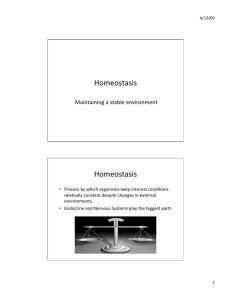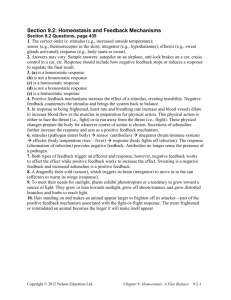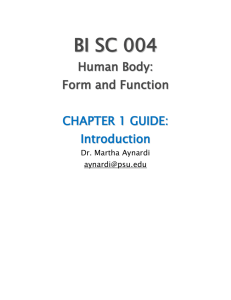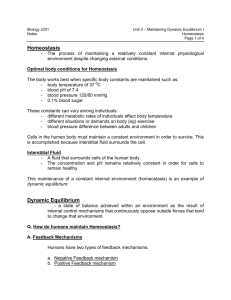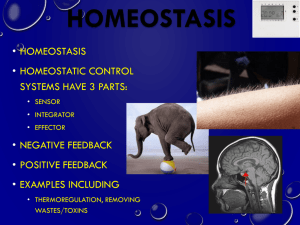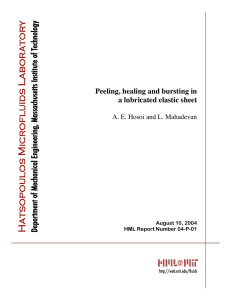INTRO LECTURE - FALL, 2011
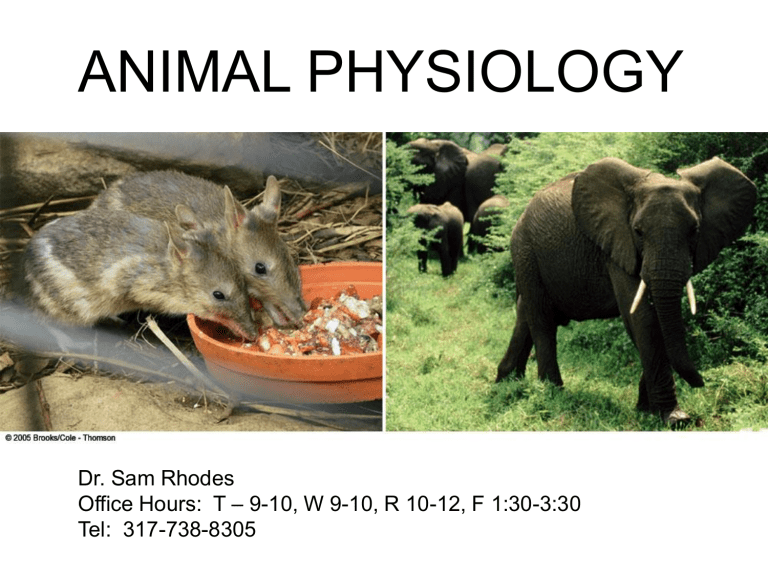
ANIMAL PHYSIOLOGY
Dr. Sam Rhodes
Office Hours: T – 9-10, W 9-10, R 10-12, F 1:30-3:30
Tel: 317-738-8305
Syllabus
Class Organization
Course Website
The Importance of the Textbook
1. What is Physiology?
Mechanistic approach
Evolutionary approach
2. The Importance of the
Hypothetico-Deductive Method
Issues of Being Multicellular
A. each cell has requirements
B. interstitial fluid
C. circulatory system
D. cells form tissues and organs that perform specialized functions for the whole organism
Cell
Intracelluar fluid
Interstitial fluid oxygen nutrients
Carbon dioxide wastes
Blood
Vessel
Plasma
Extracellular fluid
•Organs are made of two or more types of of tissue (epithelium, connective tissue muscle or nerve)
• Organ systems consist of two or more organs functioning together to serve the body
(exchange gases, obtain nutrients, void wastes
•All organ systems function together to provide the requirements of each cell in the body
Issues of Size and Scale
SA / V = 6 SA / V = 3
•Obtaining nutrients
•Voiding wastes
•Heat loss / gain
•Gas exchange
Homeostasis: maintaining a relatively constant internal environment
• Regulators (expend metabolic energy to maintain homeostasis)
• Conformers (do not expend metabolic energy to maintain homeostasis)
Maintain
Body systems
Make up
Cells
Homeostasis
Is essential
For survival of
Fig. 1-6, p.11
Major Components of a Homeostatic Control System
•Set point
•Sensor (receptor)
•Integrator
•Effector
•Feedback
Deviation in controlled variable
(detected by)
Sensor
(informs)
Integrator
(sends instructions to)
Effector(s)
(brings about)
Compensatory response
(results in)
Controlled variable restored to normal
(leads to)
Negative feedback to shut off the system responsible for the response
* Relieves
Set
Point
Fig. 1-8a, p.13
Increase in fluid concentration
Provides Negative
Feedback
Helps dilute body fluids and counteract affects of dehydration
Detected by the hypothalamus – which signals the pituitary
Pituitary releases
Antidiuretic
Hormone which acts on the kidney
Kidney produces a low volume of very concentrated urine. This helps retain more water in body
Fig. 1-8c, p.13
Controlled variable
Sensor
Higher regulator
Integrator Set point
Effector
(a) Reset control of negative feedback by a higher system or clock
Fig. 1-10a, p.17
Deviation in controlled variable
(May use a Sensor)
Integrator or regulatory process
Output
(may use an effector)
(b) Positive feedback
Accentuates the change
Fig. 1-10b, p.17
Signal from mature fetus
Uterus begins contractions
Stretch sensors
Mother’s hypothalamus
Contractions enhanced
Pituitary gland
Oxytocin secreted
(c) Example of positive feedback: birth of a mammal
Fig. 1-10c, p.17
Importance of Mathematical Modeling (Curve Fitting)
• Describe and communicate information effectively
• Make predictions about the function of a system
• Help to formulate and select from alternative hypotheses
